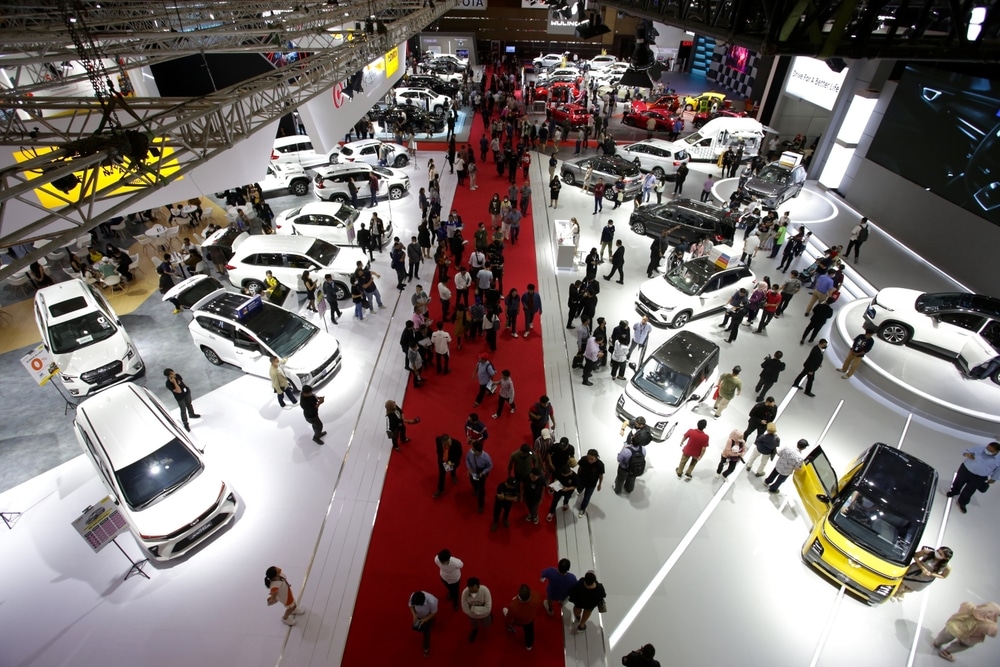
- The Savvy Promise
At Savvy, our mission is to empower you to make informed financial choices. While we maintain stringent editorial standards, this article may include mentions of products offered by our partners. Here’s how we generate income.
Savvy’s report delves into the results of Deloitte’s 2023 Global Automotive Study; comparing this with our own Australian survey data, and other sources.
- China showed the greatest desire to buy an EV as next car – 27%
- Japanese (36%) and South Koreans (27%) most likely to buy a hybrid
- Australia: 12% intend to buy an EV, while 20% will buy a hybrid
- USA most likely to buy an internal combustion engine (ICE) vehicle: 62%
As of 2023, there are many disruptions in the global automotive market.
High and persistent inflation, stretched-thin supply chains, and volatility in commodities such as oil and rare-earth minerals are causing turmoil on global car and vehicle markets.
Automotive has been the backbone of world transportation since the mid-20th Century, albeit running on petroleum and distillate (diesel.) Now, we are seeing a decided shift towards Electric Vehicles (EVs) as a cheaper, environmentally friendly alternative to Internal Combustion Engine (ICE) cars, trucks, vans, and so on.
However, with any new technology also comes potential drawbacks. New EVs, at least in Australia, are expensive relative to their ICE counterparts. Our surveys have shown only 10% of Australians are looking to purchase an EV in the next 12 months (June 2023) and EVs take up approximately 3.39% of market share in Australia (2022, Electric Vehicle Council), up 65% from the year previous. With 7.7 million km2 of country to traverse and public fast charging stations (50kW+) numbering only a handful at the moment, there is reluctance among the wider community about “range anxiety” – the fear of running out of electricity before reaching a charger – upfront prices and costs, and lack of infrastructure to support a growing number of EV users.
A report commissioned by Big 4 accountancy firm Deloitte, surveying 26,000 consumers in 24 different countries looked at the big changes and matters that are of vital importance to automotive consumers. The report tracks the perception and uptake of EVs, what consumers did amid supply chain shutdowns, and sentiment toward “Automotive Essentials as a Service” – whether traffic alerts and satellite navigation should be bundled into the cost of a vehicle or sold as a subscription service.
What does the future hold for automotive – and what are attitudes like in Australia compared with the rest of the world? We delve into the numbers of the report to show where automotive is headed in 2024 and beyond.
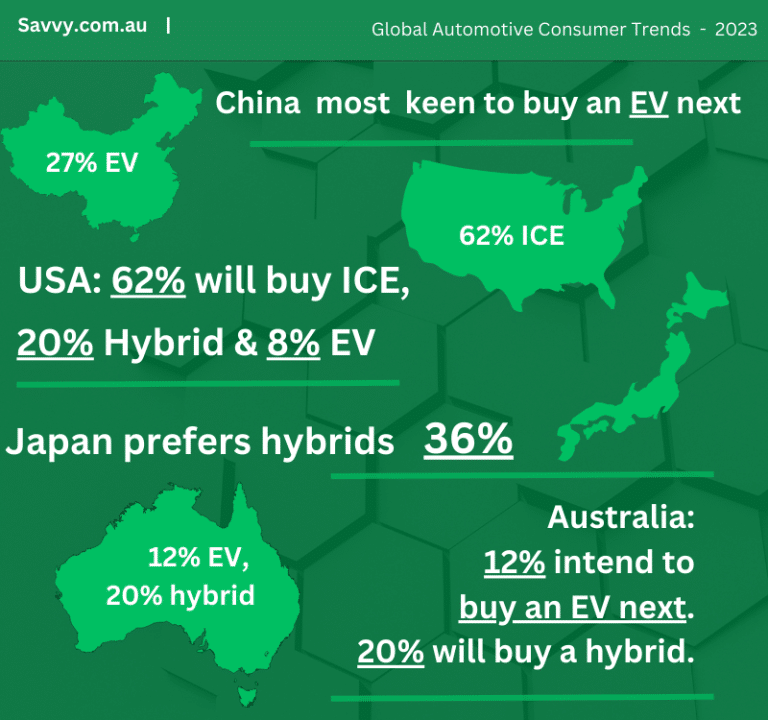
Electric Vehicles – is there a preference for them?
Asking consumers which type of engine they prefer for their next vehicle purchase, a majority of Australians (54%) expressed that they would still buy an ICE vehicle over all other types. 20% said they would prefer a Hybrid Electric (HEV, which uses a small ICE engine and a battery), a 12% said a Plug-In Hybrid (PHEV, which is similar to an HEV but can be charged using mains power), with only 8% saying they would buy a fully battery-powered electric vehicle (BEV.) This is down from over two-thirds (68%) preferring ICE vehicles in last year’s survey.
These numbers skew similarly in the United States (62% preferring ICE vs. 20% preferring HEVs) and in India (all numbers practically identical to Australia.) Major economies such as Germany a slightly higher preference for non-ICE vehicles (51% vs 49% in 2022) although their EV market share is still comparatively low compared to other European Union countries at 3.85% (2023, Statista).
According to the European Automobile Manufacturer’s Association (ACEA), 22.6% of all new car registrations were HEVs and 12.1% were BEVs, leaving Diesel vehicles in the middle (16.4%). 36.4% of all vehicles sold were ICE models. (2023, ACEA.)
Major Asian economies seemed to be leading the charge for EVs – 27% of Chinese consumers expressing a preference for BEVs, second only to petrol vehicles. Japanese consumers seem to favour ICE and HEVs equally (36%) with South Korea also favouring EVs over ICE vehicles (38% ICE vs the rest.)
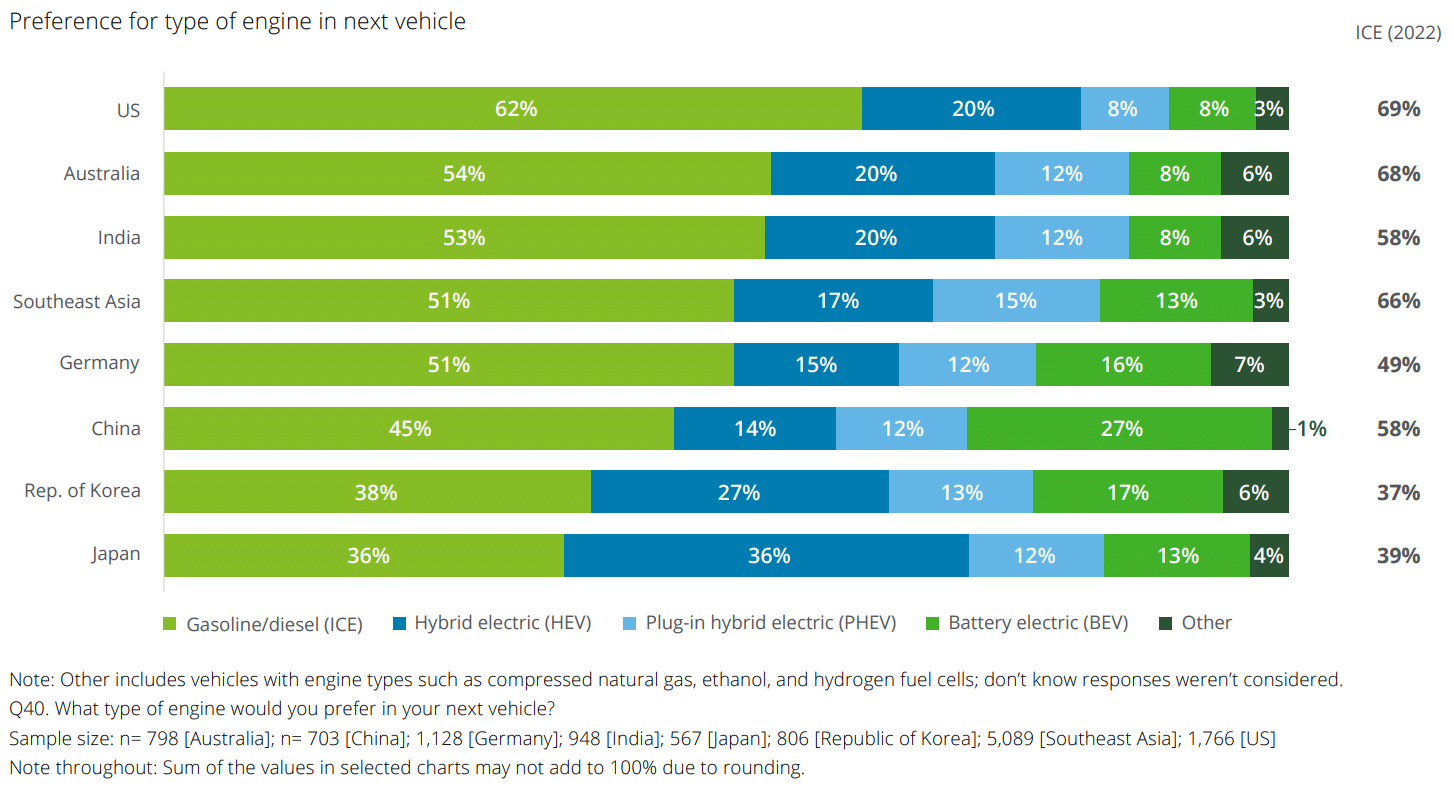
Deloitte, (2023), Pg 5, Fig. 1
As to why transitioning to EVs is a better idea than sticking with petrol or diesel, almost all countries agreed that lower fuel costs were the top reason to switch; although Chinese consumers said that an EV’s better driving experience was the main reason. Concern about climate change was low in Asian countries (China 8th out of 9 reasons, Japan, and Korea 7th out of 9) but high in Western countries such as Australia (2nd), Germany (2nd), and the US (3rd.) Government subsidies was the second top reason to buy EVs in Japan and Korea. All countries unanimously voted that peer pressure was the least significant reason to change to EVs.
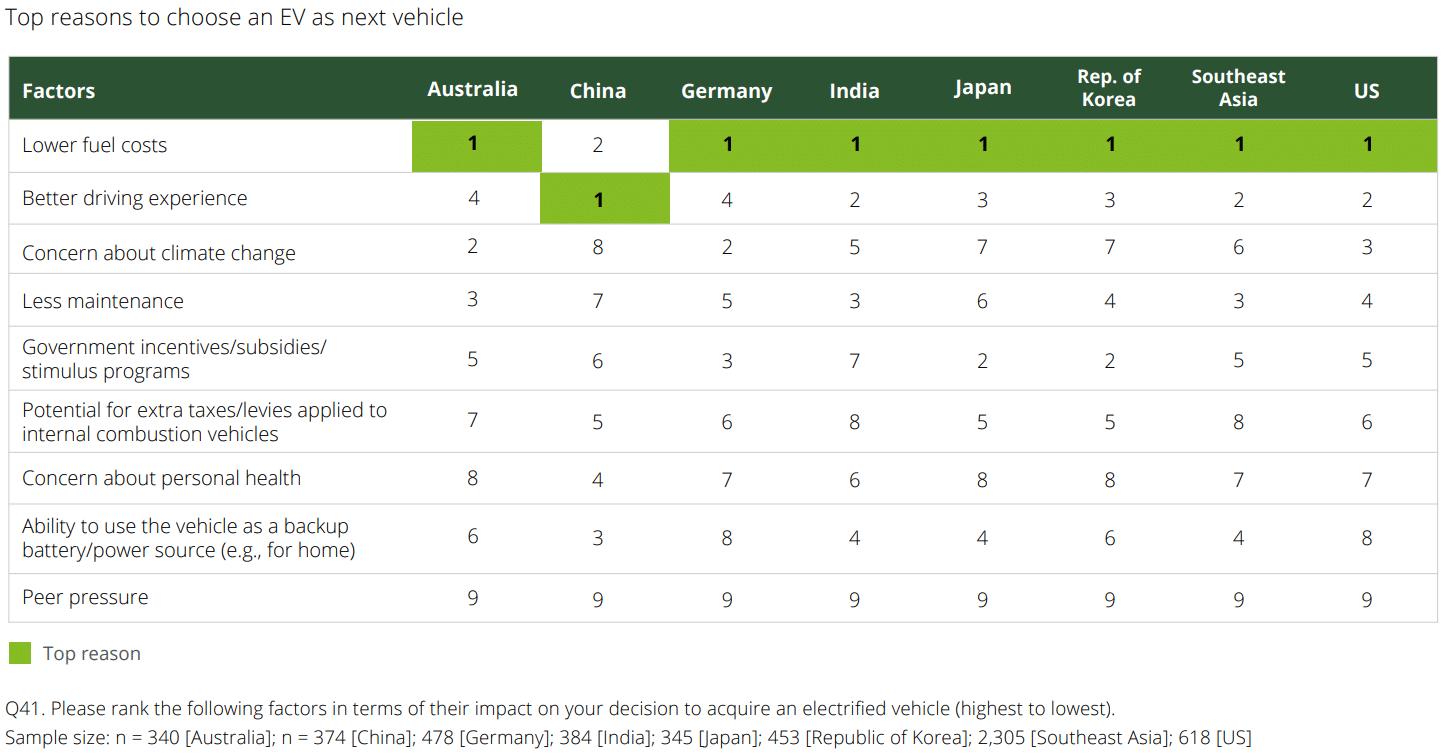
Deloitte, (2023), Pg 5, Fig. 2
Savvy's Spokesperson, Adrian Edlington, offered a thoughtful perspective on the evolving automotive landscape in the Global Automotive Consumer Trends – 2023 Report. He emphasised the growing importance of electrification and consumer sentiment in the automotive industry, particularly in Australia.
“As of 2023, there are many disruptions in the global automotive market. High and persistent inflation, stretched-thin supply chains, and volatility in commodities are causing turmoil worldwide. We are witnessing a significant shift towards Electric Vehicles (EVs) as a more affordable and environmentally friendly alternative to Internal Combustion Engine (ICE) vehicles. However, potential drawbacks, such as higher upfront prices and limited charging infrastructure, still affect the Australian market. Only 10% of Australians are looking to purchase an EV in the next 12 months, despite a 65% increase in market share since 2022.
Range anxiety – where will people charge?
As mentioned, there is a real concern that EVs, especially battery powered EVs or BEVs may run out of “fuel” before getting to a far-away destination. At current, the Tesla Model S Plaid has an approximate range of 628km on a single charge, and the dual-motor Tesla Model S Long Range offers a 663km range. These aren’t cheap, with the Plaid coming in at $186,990 and the Long-Range costing a cool $129,990.
In Australia, 77% said they would have to charge their plug-in vehicles at home, with only 7% saying they could do so at their workplace and 16% at an on-street or public charging station. The United States had the same numbers, while Germans could rely on their work a little more (13%) and public chargers a bit less (11%). In Japan, 26% of EV users could charge at a public station, with 28% of South Koreans saying the same. Japan’s biggest discrepancy among the other nations surveyed was a relative lack of workplace charging, coming in at 2%. Southeast Asia and India had high proportions of public charging stations (25% and 27%) although Chinese EV motorists have the highest access to work-based charging ports (19%.)
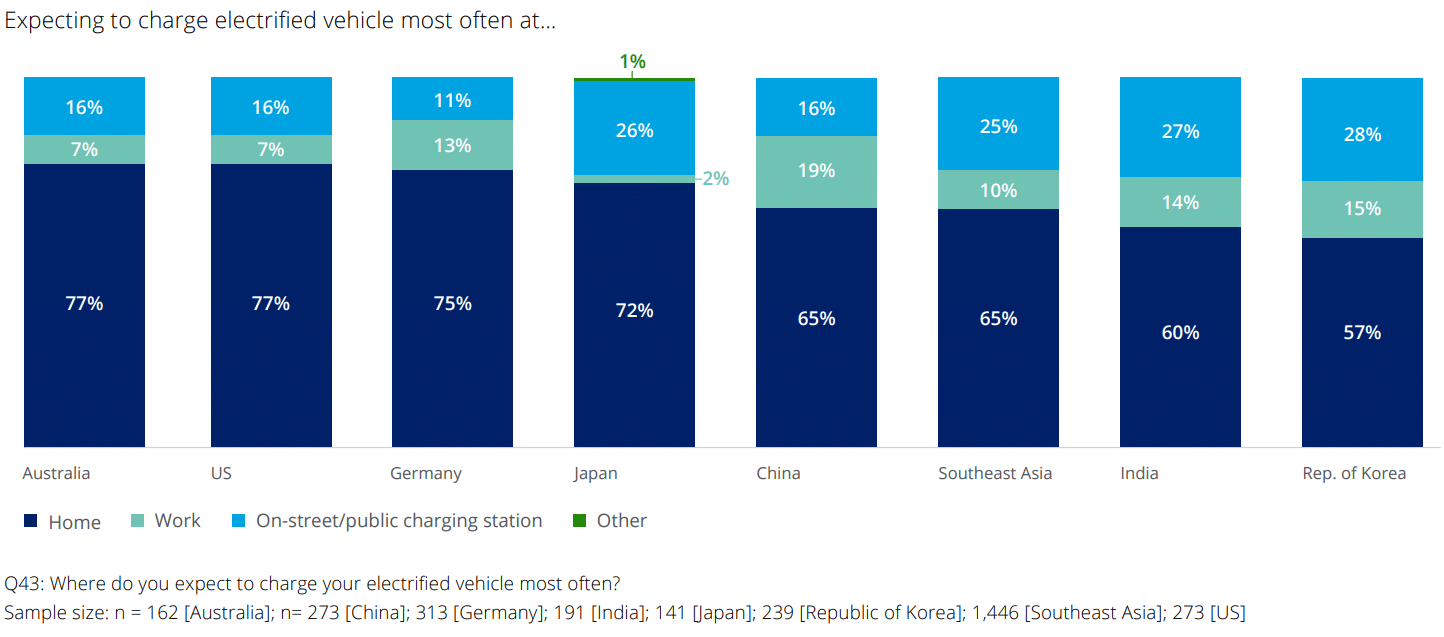
Deloitte, (2023), Pg 6, Fig. 1
Despite 72% of Japanese consumers saying they expect to charge their vehicles at home, 63% say that there is no possibility to install at home; with 23% saying it would be too expensive. With Japan residential voltages among the lowest in the world (100V at 15A) means a car would only receive a maximum of 1.65kW. Typically, 1kW of charge adds one kilometre of range to an EV every ten minutes. Therefore, the Tesla S Model Plaid would take 66 hours to charge from zero to 100% in Japan!
The cost of installation seems to be the highest barrier to entry, with 55% in China saying it costs too much; 49% of Indians, and 44% of Australians saying the same. 45% of Germans say they can’t install EV charging, while 22% of the US, India, and Australia respondents saying they are not sure how to install.
As for paying for public charging, most Western countries including Japan and South Korea preferred paying by a credit or debit card, while China, India, and Southeast Asia prefer to pay via smartphone app.
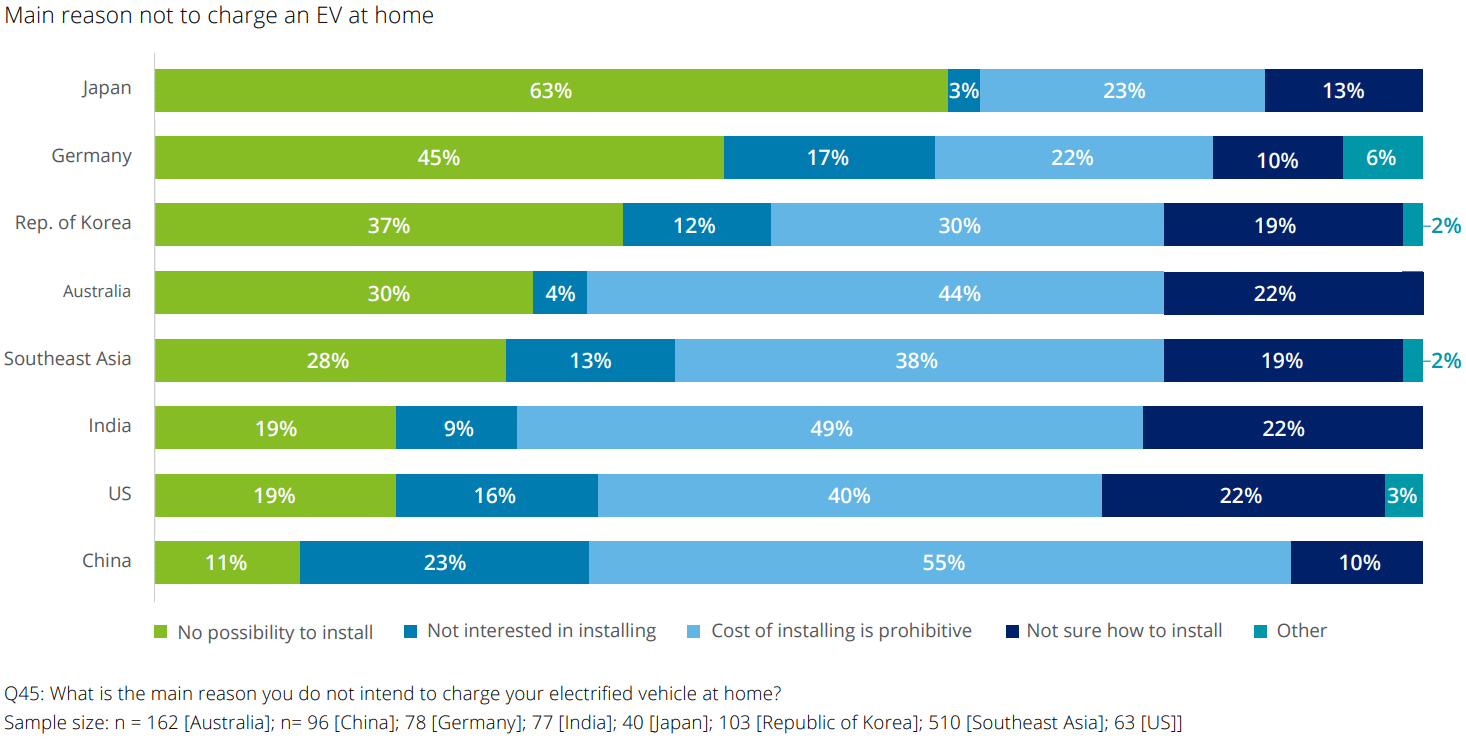
Deloitte, (2023), Pg 6, Fig. 2
Where to charge?
The next major challenge for EV owners and those thinking about installing EV infrastructure is where people will charge their vehicles while on the go. A significant proportion (over 20%) of respondents in Australia, the US, and Germany believe “any location with a charger” will do. 43% of Chinese and 39% of Southeast Asians say that a dedicated EV service station will be the norm for charging their EVs on the go. Most countries fall within the 20-25% range (apart from Japan on 36%) saying they expect to charge their EVs at a traditional service station alongside ICE vehicles. Germany was an outlier with 19% of respondents asking for charging while parked on the street.
As for waiting to charge, Aussies are the most impatient expecting a charge from 0-80% with 14% expecting it to take just less than 10 minutes! This was followed by Southeast Asia on 13% and the US on 12%.
Waiting between 10 minutes to an hour seemed to be the consensus among most countries, with 33% of Australians expecting a full charge within 20 minutes and a quarter expecting it within 40 minutes.
German and Chinese EV owners fully expect a charge to come far over the 10-minute mark – only 3% and 2% respectively expect a charge within that rapid timeframe. 72% of Germans believe that it will take more than 20 minutes but under 90 minutes; 79% of Chinese believe the same.
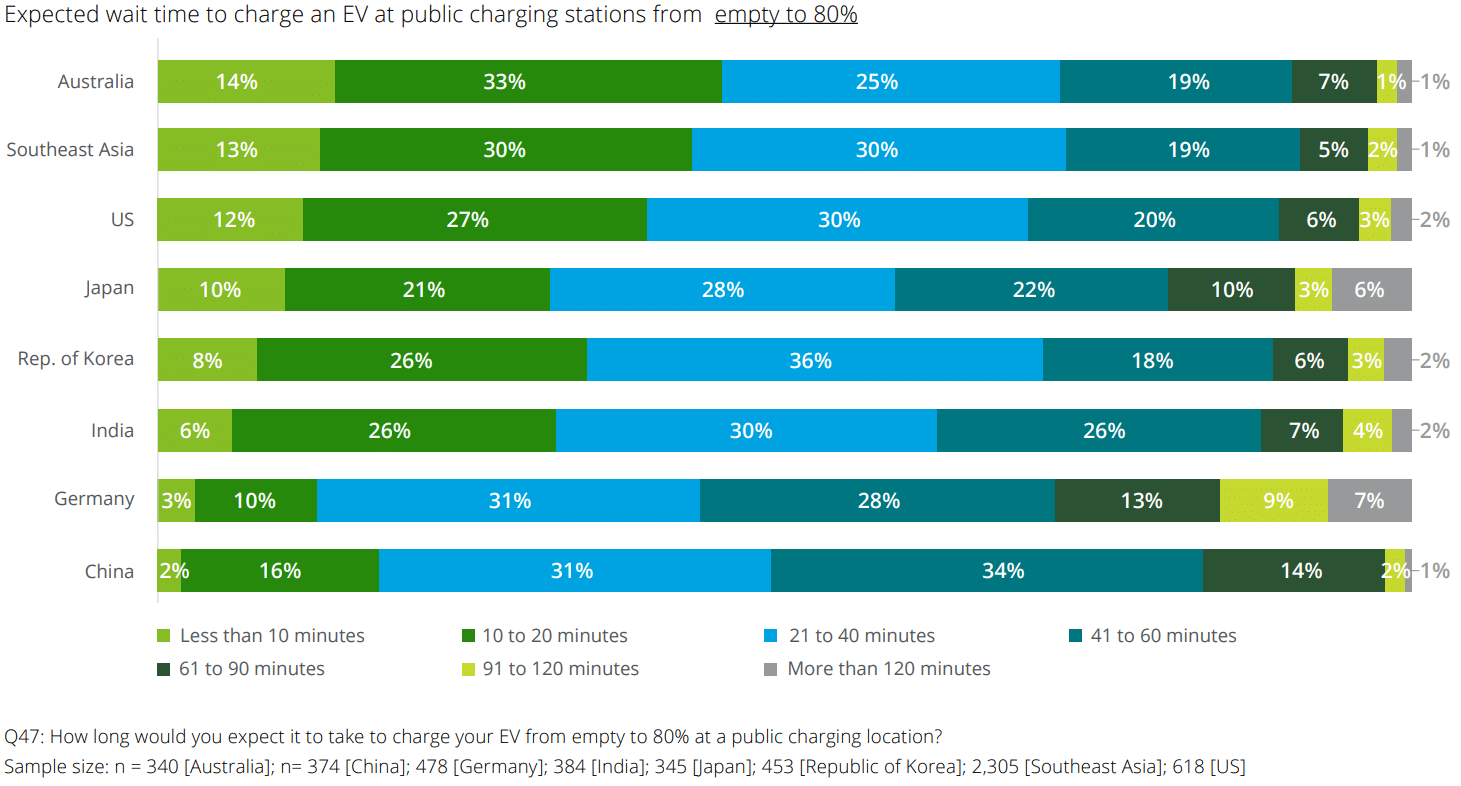
Deloitte, (2023), Pg 8, Fig. 1
As for the top choice of what creature comforts EV owners should expect at a charging station, most Asian nations will want coffee or beverage service. Chinese EV owners are split between free wi-fi and a lounge area, while Australians and Germans pick having washrooms as the dealbreaker. Most US EV owners also want Wi-Fi – though having Wi-Fi was a close second among many different nations.
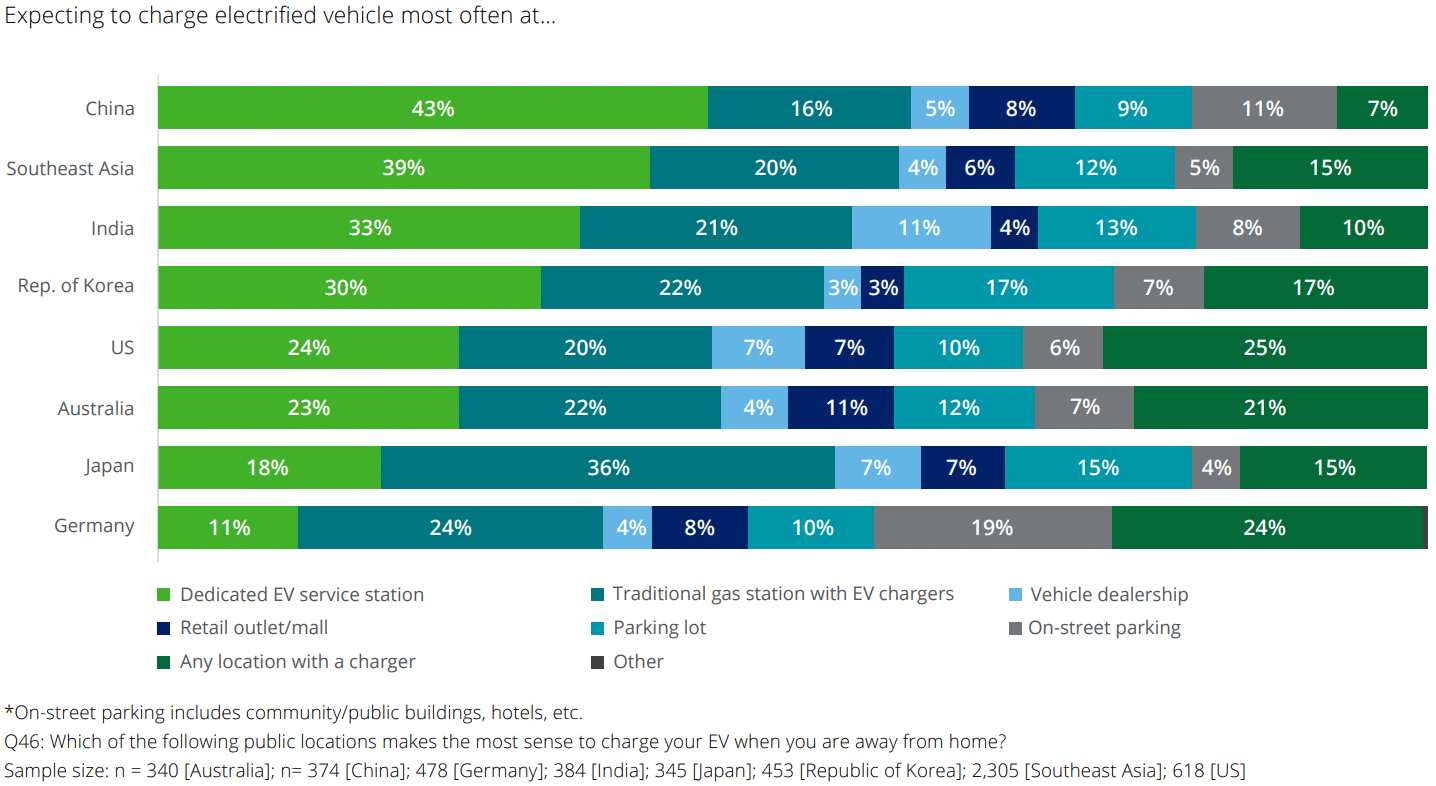
Deloitte, (2023), Pg 8, Fig. 1
EVs popular even if ICE went green
An unusual question though relevant – what would happen if we didn’t need EVs to achieve net-zero carbon emissions or positive environmental impacts? What if scientists and engineers found a way to run ICE engines on a sustainable or synthetic alternative to petrol or diesel? Would people still buy EVs?
The answer for Asian countries is that it would indeed be a gamechanger – 68% of China, 67% of India and 63% of Southeast Asian consumers reported that they would reconsider purchasing an EV in this scenario. This in direct contrast to the West where a majority say they would definitely not reconsider their purchase (as opposed to being open to it as a “maybe”) – 49% of Germany, 47% of Japanese, 44% of Americans and 40% of Australians reported they may second-guess a purchase of an EV if a clean, green ICE alternative came on to the market. 45% of Australians said they could be persuaded either way, followed by 39% of Americans. 16% of Americans, South Koreans, and Chinese said they would stick to their guns and purchase an EV.
The number where we soothe range anxiety
As discussed, “range anxiety” is the real fear that an EV battery capacity (especially one that can’t be recharged through a hybrid engine or regenerative braking) will run out between charging stations, leaving drivers in the lurch.
Most consumers in Australia – 62% expect their EV to run for over 400km – and just shy of 25% expect 600km or more. 41% of Indian consumers said they also want 400km or more, while 79% of Germans said the same. Germany was also the most demanding, with 30% expecting 600km or more – the same can be said for South Korea (28%) and Australia (24%). 34% of Chinese consumers expect their EV to travel between 400km and 499km; 54% of Southeast Asia expects their EVs to have a range of between 300km and 499km.
In the US, 22% of respondents said they expect their EV to have a range of 300 to 399 miles, followed by 19% saying they expect 600 miles or more – almost 1,000 kilometres! (965.6km).
As for the biggest concerns around EV ownership, Australia’s top concern was the price premium at present (53%). 52% said that the time required to charge was their top concern, followed by a lack of public electric vehicle charging infrastructure (51%).
Driving range was Germany’s biggest concern, while charging times were the top concerns of Japan and South Korea. India and Southeast Asia said a lack of public infrastructure was the most concerning, while Japan (equal 50%) and the US joined Australia in saying the higher costs were the biggest concern of EV ownership. 32% of Chinese consumers said that safety concerns with battery technology was their highest concern.
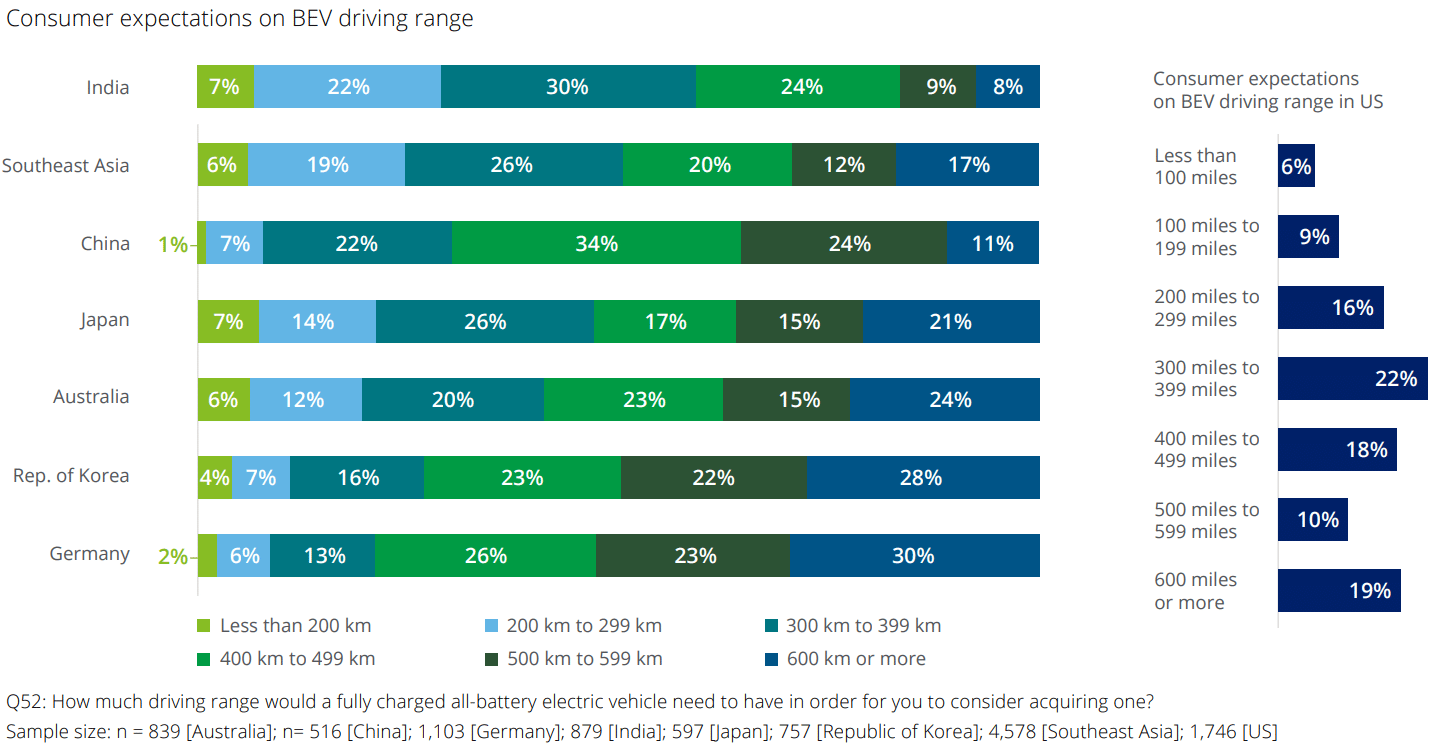
Deloitte, (2023), Pg 10, Fig. 1
The world’s next EV – purchase intentions of global automotive market
What drives you towards a certain car brand? For almost every country surveyed apart from Japan, it’s built quality. Japanese consumers favoured vehicle features over product quality. This may be due to Japan’s car manufacturing base, which has strict quality controls.
As for waiting for their car to be delivered after purchase, many consumers are content to wait from one to 12 weeks: 74% of Americans, 80% of Chinese, and 82% of Australians have almost been “trained” to hurry up and wait for their cars to arrive, possibly due to the COVID-19 pandemic and supply chain interruptions that dogged the car industry during 2020-2021.
Korean consumers were prepared to wait between 13 weeks and 25 weeks or more (31%) as are Japanese car buyers (27%).
The median range seems to be 3-4 weeks, with most regions/countries falling within that band (30-39%).
Unsurprisingly, the most important aspect of the buying experience among all countries barring China and South Korea as getting a good deal on the car. An even split in India says the test drive is most important, with South Koreans emphasising transparent pricing. Curiously, Chinese car buyers listed having a resource for post-purchase needs (after sales service) as their top priority in the buying experience.
Insurance from the manufacturer?
As manufacturers seek to add to their profit margins, some car makers are also offering car insurance as part of their suite of offerings. Though dealer or manufacturer finance is common in the West, insurance is becoming a popular option in developing countries.
86% of those surveyed in India said they would be interested in dealer/manufacturer insurance, with 76% of China and 71% South East Asia saying the same. This falls off precipitously in South Korea with only 43%. Australia was second least interested at 33% with Germany being the least interested on 27%.
For those who were interested in buying direct from the manufacturer, 46% of Australians cited cost savings as the primary benefit, with 45% of US and 44% of South Koreans saying the same. 50% of Germans said they would buy out of convenience, followed by 40% of Indians and Americans. Japanese were split on convenience and streamlined purchase process at 38%.
Where do consumers service their cars? Dealers, aftermarket, or DIY?
Australians and Americans seem to love a good bargain – 8% of Aussies and 12% of Americans prefer to go it alone and do it themselves when it comes to servicing their car. The Germany, Australia, and South Korea had the highest proportion of car owners going independent or to an aftermarket facility at 46%, 43%, and 39% respectively.
India and Japan had the most faith in after care at dealerships, with 77% of Indians going to authorised or new vehicle dealers, along with 74% of Japanese car buyers and 73% of Chinese car buyers.
As for why consumers go to a dealer, most chose the better quality of work (and perhaps OEM parts) as their top reason. Japan, South Korea, and an even split in Southeast Asia chose trust as their top reason. For those that go aftermarket, Australians, Chinese, and Southeast Asians chose the quality of work as their top reason for going independent. Trust was the main factor in Germany, India, and South Korea, while Japanese and Germans were bargain hunters – they focused mainly on cost.
Examining where trust goes, the significant plurality of trust goes towards a dealership where a consumer normally services their vehicle; with the outlier being Japan who trusts the dealership where they acquired the vehicle (45%). Japanese trusted the manufacturer or marque of the vehicle they currently owned the least (23%) along with Germany (24%) and the US and Australia (27%). 41% of Germans said they trust the dealership where they normally get service the most (41%).
Apps and connectivity
Having seamless integration with smart devices and cars is expected in the automotive market and are ready and willing to share their personal information with manufacturers and third parties to get tangible benefits in return. Australia, India, Southeast Asia, and the US said they were most interested in getting vehicle health reporting and telemetry from an app – with 84% of Indian consumers reporting this to the survey, along with 81% in Southeast Asia. Western nations did list it as their top interest, but at lower numbers: 63% in Australia and 60% in the US.
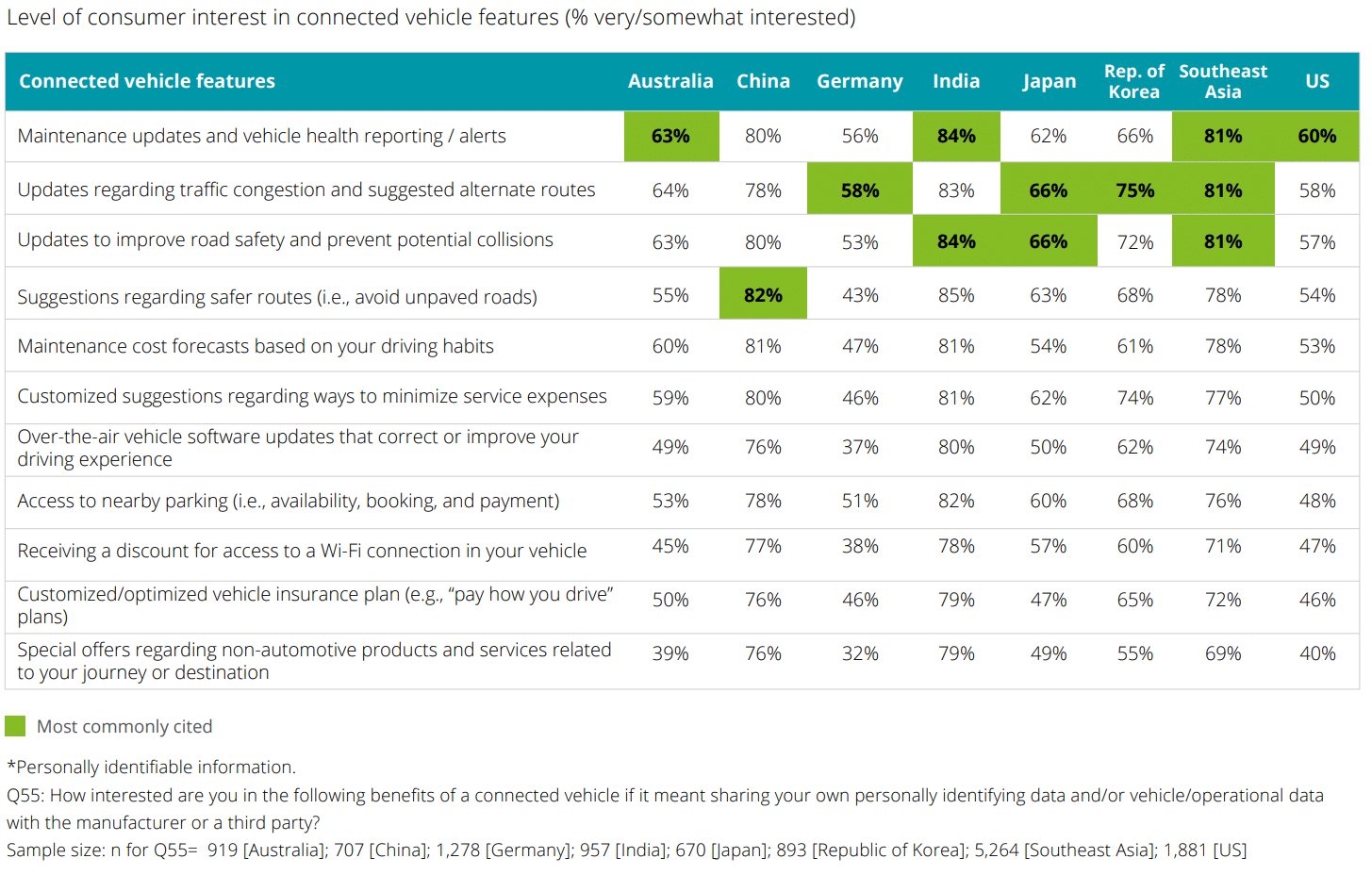
Deloitte, (2023), Pg 18, Fig. 1
The next most called for feature is traffic updates and alternate routing in Germany, India (equal 1st), Japan, South Korea, and Southeast Asia (equal 1st.) India, Japan, and Southeast Asia said software updates to improve road safety was most important. China was the outlier, with 82% saying they wanted suggestions regarding safer routes, such as avoiding unsealed roads.
As for providing these services as a subscription service, manufacturers will have a hard sell. Only 21% of Japanese and Southeast Asia customers would welcome this model, the highest proportion in the study. Only a majority of South Koreans would welcome a per-use charge model (54%) followed by Germany (44%) and Southeast Asia (43%). 54% of China, 50% of Australia, and 49% of India would rather pay for these services up front as part of the vehicle purchase price.
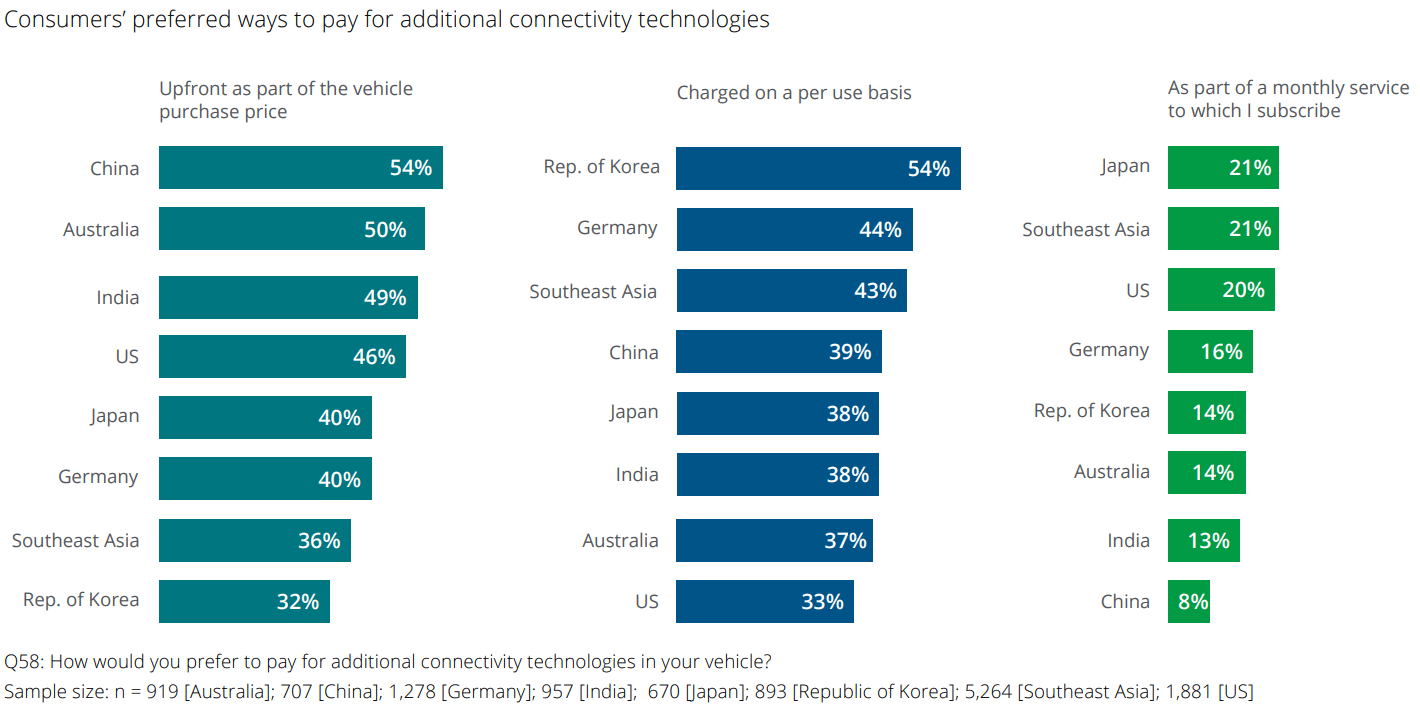
Deloitte, (2023), Pg 18, Fig. 2
What’s next?
With apps and electrification becoming the norm, global manufacturers will need to catch up with connectivity and the EV future. Though 2024 may show a gradual progression to EVs, better safety and features will be the big incentives for would-be car buyers to pony up their dough; and the marques that are slow to react may need to have a big wake-up call.
Did you find this page helpful?
This guide provides general information and does not consider your individual needs, finances or objectives. We do not make any recommendation or suggestion about which product is best for you based on your specific situation and we do not compare all companies in the market, or all products offered by all companies. It’s always important to consider whether professional financial, legal or taxation advice is appropriate for you before choosing or purchasing a financial product.
The content on our website is produced by experts in the field of finance and reviewed as part of our editorial guidelines. We endeavour to keep all information across our site updated with accurate information.









